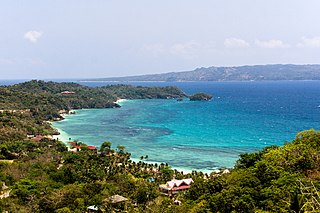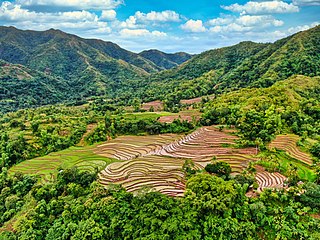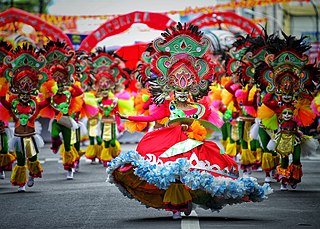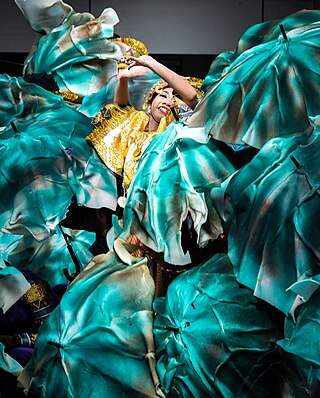
The Visayas, or the Visayan Islands, are one of the three principal geographical divisions of the Philippines, along with Luzon and Mindanao. Located in the central part of the archipelago, it consists of several islands, primarily surrounding the Visayan Sea, although the Visayas are also considered the northeast extremity of the entire Sulu Sea. Its inhabitants are predominantly the Visayan peoples.

Aklan, officially the Province of Aklan, is a province in the Western Visayas region of the Philippines. Its capital is Kalibo. The province is situated in the northwest portion of Panay Island, bordering Antique to the southwest, and Capiz to the southeast. Aklan faces the Sibuyan Sea and Romblon province to the north.

Antique, officially the Province of Antique, is a province in the Philippines located in the Western Visayas region. Its capital is San Jose de Buenavista, the most populous town in Antique. The province is situated in the western section of Panay Island and borders Aklan, Capiz and Iloilo to the east, while facing the Sulu Sea to the west.

Kalibo, officially the Municipality of Kalibo, is a first-class municipality and capital of the Province of Aklan, Philippines. According to the 2020 census, it has a population of 89,127 people.

Tigbauan, officially the Municipality of Tigbauan, is a 2nd class municipality in the province of Iloilo, Philippines. According to the 2020 census, it has a population of 65,245 people.

The Kalibo Santo Niño—Ati-Atihan Festival, also simply called Ati-Atihan Festival, is a Philippine festival held annually in January in honor of the Santo Niño in several towns of the province of Aklan, Panay Island. The biggest celebration is held during the third Sunday of January in the town of Kalibo, the province's capital. The name Ati-Atihan means "to imitate the Ati people".

Batan, officially the Municipality of Batan, is a 4th class municipality in the province of Aklan, Philippines. According to the 2020 census, it has a population of 33,484 people.

Nabas, officially the Municipality of Nabas, is a 4th class municipality in the province of Aklan, Philippines. Nabas serves as the arrival gateway of Boracay Airport. According to the 2020 census, it has a population of 40,632 people, making it the fifth most populous town in Aklan Province..

Cuyo, officially the Municipality of Cuyo, is a 4th class municipality in the province of Palawan, Philippines. According to the 2020 census, it has a population of 23,489 people.

The Sandugo Festival is an annual historical celebration that takes place every year in Tagbilaran City on the island of Bohol in the Philippines. This festival commemorates the Treaty of Friendship between Datu Sikatuna, a chieftain in Bohol, and Spanish conquistador Miguel López de Legazpi. This 16th-century peace treaty occurred on March 16, 1565 through a blood compact or "sandugo".
The Hiligaynon people, often referred to as Ilonggo people or Panayan people, are the second largest subgroup of the larger Visayan ethnic group, whose primary language is Hiligaynon, an Austronesian language of the Visayan branch native to Panay, Guimaras, and Negros. They originated in the province of Iloilo, on the island of Panay, in the region of Western Visayas. Over the years, inter-migrations and intra-migrations have contributed to the diaspora of the Hiligaynon to different parts of the Philippines. Today, the Hiligaynon, apart from the province of Iloilo, also form the majority in the provinces of Guimaras, Negros Occidental, Capiz, South Cotabato, Sultan Kudarat, and North Cotabato.

The Ati are a Negrito ethnic group in the Visayas, the central portion of the Philippine archipelago. Their small numbers are principally concentrated in the islands of Boracay, Panay and Negros. They are genetically related to other Negrito ethnic groups in the Philippines such as the Aeta of Luzon, the Batak of Palawan, the Agta of the Sierra Madres, and the Mamanwa of Mindanao.

The MassKara Festival is an annual festival with highlights held every 4th Sunday of October in Bacolod, Philippines. The festival sites include the Bacolod Public Plaza, the Lacson Tourism Strip and the Bacolod City Government Center.
The Aklanon people are the ethnolinguistic group who lived in the province of Aklan. They are part of the wider Bisaya ethnolinguistic group, who constitute the largest Filipino ethnolinguistic group.

The Maragtas is a work by Pedro Alcantara Monteclaro titled History of Panay from the first inhabitants and the Bornean immigrants, from which they descended, to the arrival of the Spaniards. The work is in mixed Hiligaynon and Kinaray-a languages in Iloilo in 1907. It is an original work based on written and oral sources available to the author.

The Dinagyang Festival is a religious and cultural festival in Iloilo City, Philippines, held annually on the fourth Sunday of January in honor of Santo Niño, the Holy Child. It is one of the largest festivals in the Philippines, drawing hundreds of thousands to over a million visitors every year.

Evelio Bellaflor Javier was a Filipino politician. He served as governor of the province of Antique and was an opponent of the dictatorship of President Ferdinand Marcos. His assassination on February 11, 1986, was one of the causes of the People Power Revolution that overthrew Marcos. Evelio Javier's brother, Exequiel Javier, served as congressman from 1987 to 1998 and from 2001 to 2010 and governor from 1998 to 2001, and 2010 to 2015. In 2018, Javier was identified as a Motu Propio human rights violations victim of the Martial Law Era by the Human Rights Victims Claims Board.

The Confederation of Madja-as was a legendary pre-colonial supra-baranganic polity on the island of Panay in the Philippines. It was mentioned in Pedro Monteclaro's book titled Maragtas. It was supposedly created by Datu Sumakwel to exercise his authority over all the other datus of Panay. Like the Maragtas and the Code of Kalantiaw, the historical authenticity of the confederation is disputed, as no other documentation for Madja-as exists outside of Monteclaro's book. However, the notion that the Maragtas is an original work of fiction by Monteclaro is disputed by a 2019 Thesis, named "Mga Maragtas ng Panay: Comparative Analysis of Documents about the Bornean Settlement Tradition" by Talaguit Christian Jeo N. of the De La Salle University who stated that, "Contrary to popular belief, the Monteclaro Maragtas is not a primary source of the legend but is rather more accurately a secondary source at best" as the story of the Maragtas also appeared in the Augustinian Friar, Rev. Fr. Tomas Santaren’s Bisayan Accounts of Early Bornean Settlements Additionally, the characters and places mentioned in the Maragtas book, like Rajah Makatunaw and Madj-as can be found in Ming Dynasty Annals and Arabic Manuscripts. However, the written dates go earlier since Rajah Makatunaw was recorded to have been from 1082 AD and was a descendant of Seri Maharajah while the Code of Maragtas, a separate work from the Maragtas book, placed him at the 1200s.

The Kasadyahan Festival is a cultural festival that is part of the larger Dinagyang Festival held annually on the fourth Saturday of January in Iloilo City, Philippines. It precedes the main highlight of Dinagyang, the Ati Tribe Competition, which takes place the following day on Sunday. It is a competition among cultural festivals from different cities and towns in the Western Visayas region.

















